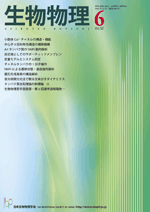All issues

Volume 52, Issue 6
Issue 304
Displaying 1-19 of 19 articles from this issue
- |<
- <
- 1
- >
- >|
Perspective
-
Yoshie HARADA2012Volume 52Issue 6 Pages 263
Published: 2012
Released on J-STAGE: November 27, 2012
JOURNAL FREE ACCESSDownload PDF (140K)
Overview
-
Masahiro Enomoto, Noboru Ishiyama, Min-Duk Seo, Fernando J. Amador, Pe ...2012Volume 52Issue 6 Pages 266-271
Published: 2012
Released on J-STAGE: November 27, 2012
JOURNAL FREE ACCESSCalcium (Ca2+) release from the sarco/endoplasmic reticulum stores generates vital regulatory signals in eukaryotes. The two major groups of Ca2+ release channels include the ubiquitously expressed inositol 1,4,5-trisphosphate receptors (IP3Rs) and the ryanodine receptors (RyRs). This review focuses on recently reported structural findings on the N-terminal regions of IP3Rs and RyRs and their arrangement into full-length tetrameric channels, revealing remarkable mechanistic homologies in Ca2+-release function. Additionally, we discuss genomic analyses identifying this class of Ca2+ release channels in unicellular organisms and the implications of these data in understanding the molecular evolution of these fundamental receptors in nature.
View full abstractDownload PDF (2889K) -
Masafumi HIRONO2012Volume 52Issue 6 Pages 272-277
Published: 2012
Released on J-STAGE: November 27, 2012
JOURNAL FREE ACCESSCentrioles are cell organelles consisting of nine triplet microtubules arranged in rotational symmetry. This structure is highly conserved among various eukaryotic organisms and serves as the template for the “9 + 2” or “9 + 0” structures of ciliary axonemes. How this nine-fold symmetrical structure forms is a long-standing question. Recently, genetic approaches using Chlamydomonas revealed that the cartwheel, a sub-centriolar structure with a hub and nine spokes, plays a pivotal role in the establishment of nine-fold symmetry, and that a protein called SAS-6 is a key component of the cartwheel assembly. This review summarizes the Chlamydomonas studies and recent advances in the understanding the SAS-6 function.
View full abstractDownload PDF (1040K)
Review
-
Hideyasu OKAMURA2012Volume 52Issue 6 Pages 278-282
Published: 2012
Released on J-STAGE: November 27, 2012
JOURNAL FREE ACCESSArf-family small G proteins participate in many cellular functions via their characteristic GTP/GDP conformational cycles, during which a nucleotide·Mg2+-binding site communicates with a remote N-terminal helix. We recently reported a study of the dynamics of an Arf-family protein, Arl8, under various conditions by means of NMR relaxation spectroscopy. The data indicated that, when GDP is bound, the protein core, which does not include the N-terminal helix, reversibly transition between an Arf-family GDP form and another conformation that resembles the Arf-family GTP form. In this review, I discuss the conformational interplay between the nucleotides, the helix, the protein core, and Mg2+.
View full abstractDownload PDF (1281K) -
Ryugo TERO, Takehisa DEWA2012Volume 52Issue 6 Pages 283-286
Published: 2012
Released on J-STAGE: November 27, 2012
JOURNAL FREE ACCESSWe describe our recent researches relating to the effects of solid supports on the structure, physical properties and chemical reactivity of supported lipid bilayer membranes, which we apply as model membrane reaction fields. Mica and SiO2/Si, most widely used “inert” substrates, showed considerable difference in the two-dimensional domain formation and reactivity to amyloid β peptides in supported membranes containing ganglioside GM1. Tethered-type supported membrane containing photosynthetic membrane proteins, LH2 and LH1-RC, retains the function of intermolecular energy transfer, and achieved the remarkable improvement in the lateral diffusion of proteins and lipid compared with conventional supported membrane.
View full abstractDownload PDF (1706K)
Topics
-
Kazuhiro AOKI2012Volume 52Issue 6 Pages 287-288
Published: 2012
Released on J-STAGE: November 27, 2012
JOURNAL FREE ACCESSDownload PDF (458K) -
Toru IDE, Minako HIRANO, Daichi OKUNO2012Volume 52Issue 6 Pages 289-290
Published: 2012
Released on J-STAGE: November 27, 2012
JOURNAL FREE ACCESSDownload PDF (620K) -
Yuki TAKAYAMA, G. Marius CLORE2012Volume 52Issue 6 Pages 291-292
Published: 2012
Released on J-STAGE: November 27, 2012
JOURNAL FREE ACCESS
Supplementary materialDownload PDF (512K) -
Yoshikazu TANAKA2012Volume 52Issue 6 Pages 293-294
Published: 2012
Released on J-STAGE: November 27, 2012
JOURNAL FREE ACCESSDownload PDF (892K)
Theoretical and experimental techniques
-
Kunihiko ISHII, Tahei TAHARA2012Volume 52Issue 6 Pages 295-298
Published: 2012
Released on J-STAGE: November 27, 2012
JOURNAL FREE ACCESSDownload PDF (802K)
Salon
-
Masahiro KINOSHITA, Kuniaki NAGAYAMA2012Volume 52Issue 6 Pages 300-303
Published: 2012
Released on J-STAGE: November 27, 2012
JOURNAL FREE ACCESSDownload PDF (704K) -
Kei YURA2012Volume 52Issue 6 Pages 304-305
Published: 2012
Released on J-STAGE: November 27, 2012
JOURNAL FREE ACCESSDownload PDF (553K)
Activity of Regional Branch
-
2012Volume 52Issue 6 Pages 306-307
Published: 2012
Released on J-STAGE: November 27, 2012
JOURNAL FREE ACCESSDownload PDF (862K)
Young Voice
-
2012Volume 52Issue 6 Pages 308-309
Published: 2012
Released on J-STAGE: November 27, 2012
JOURNAL FREE ACCESSDownload PDF (517K)
Letters from Abroad
-
2012Volume 52Issue 6 Pages 310-311
Published: 2012
Released on J-STAGE: November 27, 2012
JOURNAL FREE ACCESSDownload PDF (545K)
Technical term
-
2012Volume 52Issue 6 Pages 277
Published: 2012
Released on J-STAGE: November 27, 2012
JOURNAL FREE ACCESSDownload PDF (51K) -
2012Volume 52Issue 6 Pages 299_1
Published: 2012
Released on J-STAGE: November 27, 2012
JOURNAL FREE ACCESSDownload PDF (104K)
Book Review
-
2012Volume 52Issue 6 Pages 299_2
Published: 2012
Released on J-STAGE: November 27, 2012
JOURNAL FREE ACCESSDownload PDF (142K) -
2012Volume 52Issue 6 Pages 312
Published: 2012
Released on J-STAGE: November 27, 2012
JOURNAL FREE ACCESSDownload PDF (261K)
- |<
- <
- 1
- >
- >|